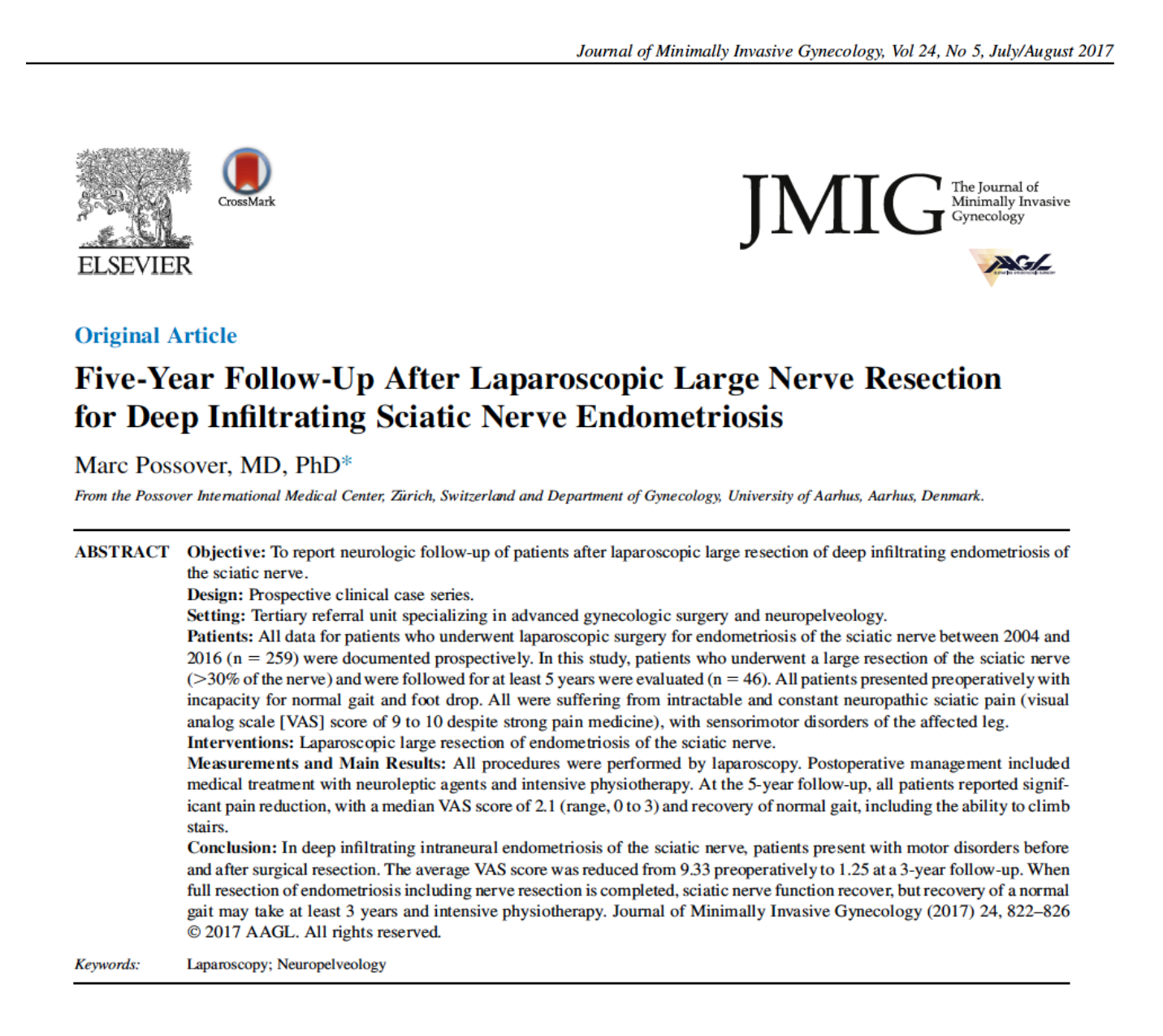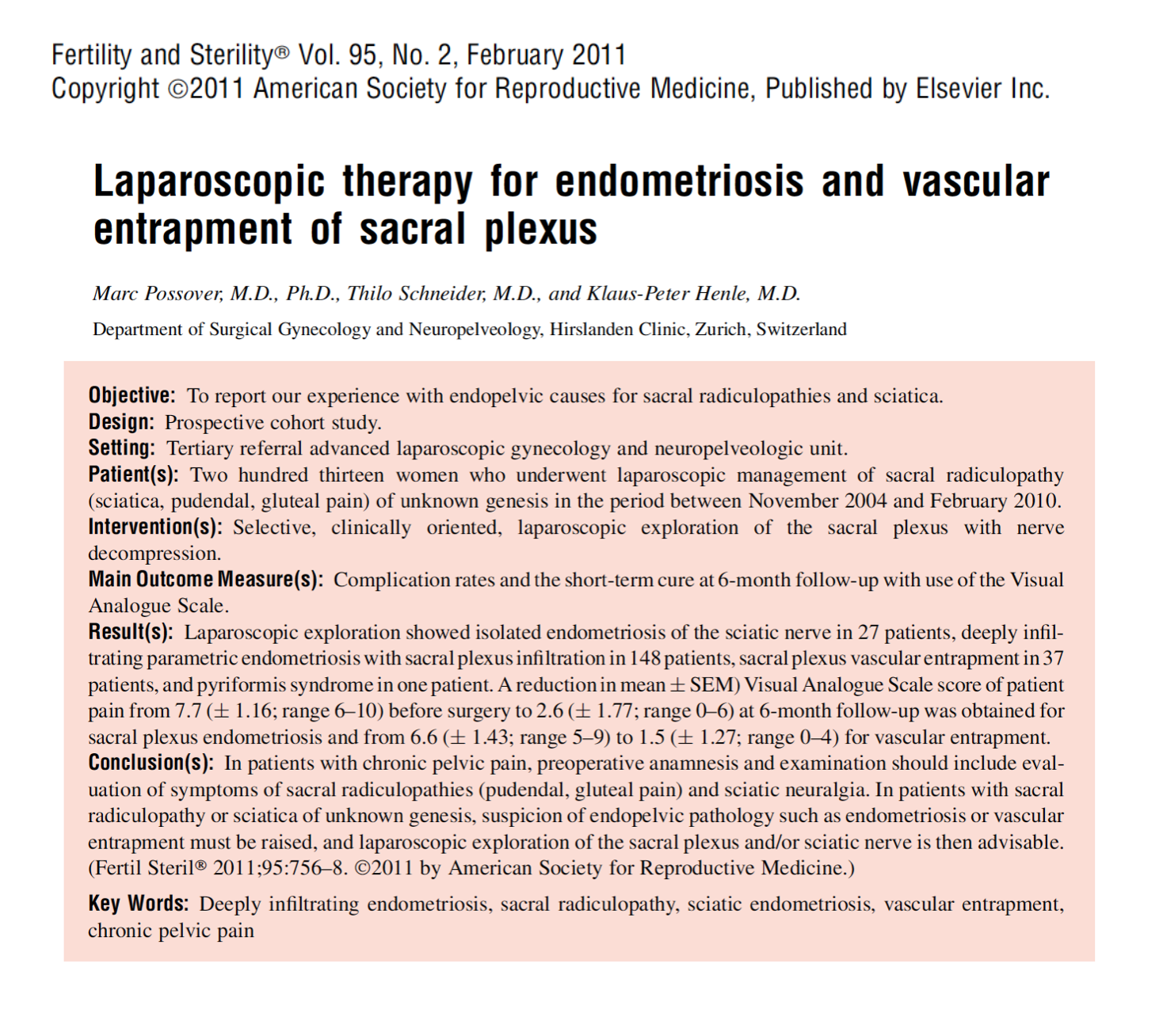
 Overview
OverviewWe report here on our experience over the last 15 years in more than 300 patients affected by a deeply infiltrating endometriosis of the sciatic nerve or of the sacral plexus. The average age of all the patients was around 30 years old. All patients underwent diverse medical treatments and diagnostic workups with suspicion of a piriform syndrome, a facet syndrome or “idiopathic sciatica”. In all these patients we performed a laparoscopic resection of the endometriosis with release of the sciatic nerve or even partial resection of the nerve, in the cases where the disease had already been involved and partially destroyed the sciatic nerve. We have reported in detail on our long-term results in several scientific publications (see below). In approx. 80% of patients after laparoscopic nerve release (without nerve resection), patients reported a significant reduction of pain of approximately more than 50% after 20 months of postoperative follow-up. In the patients with an extended resection of the sciatic nerve (resection of 30% to 70% of the nerve), the recovery took longer, but in these cases also, patients reported at 5-years follow up on a significant pain reduction according to the VAS score, pre-surgery of 9.33 under medical pain management down to 1.25 post-surgery, without any medications (VAS Score 0= no pain / 10 = maximum possible pain).


Deep infiltrating endometriosis is usually associated with a multitude of symptoms and constitutes a complex treatment challenge. Awareness that endometriosis of the pelvic somatic nerves does exist, has increased over the last few years, but lack of diagnosis and a challenging surgical treatment means that this condition is still largely unknown and as a result, often underestimated. Sciatic endometriosis is not extremely common, but it should always be included in the diagnostic approach to pain and symptoms affecting the sciatic nerve distribution. Endometriosis of the sciatic nerve must be considered in the differential diagnosis in all young patients suffering from cyclical sciatic pain, especially when orthopedic and spinal conditions have been excluded. While infiltration of the pelvic sidewall and of the sacral plexus may be predominantly left-sided, sciatic nerve endometriosis is predominantly right-sided. At the outset of the illness, pain may begin just before menstruation and last several days after the end of menstrual flow. Left untreated, neuropathic pain will lose its cyclical nature, becoming more constant in nature and resilient to strong pain medication. Because of nerve damage through deep infiltration and partial destruction of the nerve, sciatic pain will be accompanied by motor deficits with gait disorders and foot drop, cramping and/or numbness radiating down the leg. At this stage, physical examination may reveal various neurological deficits.
While sacral plexus endometriotic radiculopathies are usually part of parametric endometriosis, endometriosis of the sciatic nerve can be isolated even without any history of pelvic endometriosis. The pathogenesis is then still unknown and laparoscopic exploration of the sciatic nerve is indicated as soon as possible and before neurologic disorders set in.
he “sacral nerve roots” consist of four to five nerve roots that emanate from the spinal cord and enter the pelvis by passing through the sacrum. The sacral plexus lies at the back of the pelvis, in front of the piriformis muscle and the pelvic fascia. In front of it are the pelvic sidewall vessels, the ureter, and the sigmoid colon. The fusion of the nerves together forms within the pelvis – and protected by the pelvic bone - the sciatic nerve. It then leaves the pelvis in close anatomic relationship to the pudendal nerve (nerve of the genito-anal areas that control the urinary and fecal continence), passes into the buttock deep behind the gluteal muscles and descends into the leg and down to the foot. Contrary to popular opinion, the sciatic nerve is not the major nerve associated with walking. The sciatic nerve is mostly engaged in controlling the muscles of the buttocks for stabilization of the pelvis, the muscles of the dorsal aspect of the legs, ankles and toes. The main muscles involved in walking are the quadriceps. These muscle groups are controlled by another nerve, namely the femoral nerve. This nerve can also be affected by endometriosis, but such a condition is even more seldom than endometriosis of the sciatic nerve.
Endometriosis of the sacral nerve roots ( also called the “sacral plexus”)
This form of nerve endometriosis is usually part of a deeply infiltrating endometriosis of the support bands of the uterus (parameters, sacrouterine ligaments..) or of the “rectovaginal septum”. When deeply infiltrating endometriosis affects the ureter, suspicion of sacral plexus endometriosis must be always considered. Sacral plexus endometriosis usually affects the lower sacral nerves roots (sacral nerves root #2,3 and 4), and may affect:
Therefore, sacral plexus endometriosis typically combines symptoms such as:
With this form of pelvic nerve endometriosis, problems with standing and walking are generally absent. Because endometriosis of the sacral plexus is located deep in the lower pelvis, a diagnosis is usually easily done by trans-vaginal palpation.
Because sacral plexus endometriosis mostly surrounds the nerves - but does not grow inside the nerves - laparoscopic endometriosis resection does mostly not required resection of part of the nerves. However, when parametric endometriosis involves the “pelvic splanchnic nerves”, the nerves which emerge from the sacral plexus and are mainly involved in the voiding function of the bladder/rectum and sexuality -, sparing of these small nerves out of the disease is currently technically not feasible (with current surgical techniques and instruments). In order not to compromise the bladder and intestinal functions, sparing of these nerves of the contralateral side is mandatory and regular postoperative monitoring of bladder emptying with ultrasonic measurements are required.
Endometriosis of the sciatic nerve
If pain is typically reported as cyclical, patients affected by an endometriosis of the sciatic nerve will always present after a few months with constant and massive sciatic pain, despite strong pain medication and hormonally-induced amenorrhea. Pain typically extends from the lower back through the buttocks down the back of the leg, and even to the foot and toes. The pain is extremely strong with an average pain-score varying between 8 and 10/10. Patients describe the pain sensation as burning, electrical or tingling pain. In contrary to sciatica of spinal origins, pain never irradiate to the front of the leg. In advanced cases, when the endometriosis starts to involve and to destroy part of the sciatic nerve, the patient will rapidly present some cutaneous numbness in the legs or foot and will develop gait disorders such as weakness in walking, foot drop, walking only with assistance of a person, use of crutches or even in very few cases the need for a wheel chair. Patients may also present some difficulties with standing on tiptoes and climbing stairs may be only feasible using the handrail.
Because of close the anatomical relationship of the sciatic nerve with the pudendal nerve (endometriosis of the sacrospinal ligament), some patients will also suffer from pudendal pain, vulvodynia or coccygodynia and urinary imperiosities, frequently in combination to sciatic pain.
Medical treatment vs. surgery
Even if laparoscopic surgery is currently the method of choice for treating deep infiltrating endometriosis of the pelvic organs, surgeons should always consider both the advantages and the risks involved with any procedure. That a resection of deep infiltrating endometriosis of the sciatic nerve may serve to improve a patient`s pain situation has already been reported on in the past but neuro-functional outcomes after surgery of the sciatic nerve is yet still unknown territory. Because of the danger of more permanent damage to the nerves, some authors advise that surgical exploration of the sciatic nerve is not thought to be necessary in most cases. 1995, DeCesare et al. reported on only one case of sciatic nerve endometriosis that had responded to medical management. More recently, Aranyi et al. reported on two pre-menopausal women affected by an endometriosis of the sciatic nerve. The first patient was treated with a gonadotropin-releasing hormone agonist that obviously led to complete morphologic remission. Data that may prove efficiency of medical/hormonal treatments on a long-term basis do not exist however. In our study - and to the best of our knowledge - we have the largest series of laparoscopic procedures for deeply infiltrating endometriosis of the sciatic nerve in the world - all patients reported about a systematic exponential worsening of gait disorders while neuropathic pain became refractory to initial drug treatments and drug-induced amenorrhea in just few months or even weeks. According to our findings, to treat pain with drug-induced amenorrhea is legitimate, but as soon as gait disorders and foot drop are involved, to not advise surgical treatment is then unacceptable and even negligent, since it exposes patients to further irreversible neurogenic damage. Both surgical resection and expectative/hormonal treatments may induce neurogenic damage but with one major difference: expectative and/or hormonal treatment will induce increasing and irreversible nerve damage while resection of endoneural endometriosis will open the door for nerve recovery/reconnection with most probably the recovery of loss of functions.
Open vs. laparoscopic surgery
In pelvic nerve pathologies, the major problem for both etiological diagnosis and treatment is the surgical approach. Two open-surgical approaches have been described by neurosurgeons, the anterior abdominal approach with a longitudinal wide incision and the dorsal approach via a back incision with removal of the sacral bone. Both approaches are laborious and expose patients to risks of infection, visceral injury and severe hemorrhage, even more so because classical neurosurgical instruments and microscopes are inappropriate for procedures in such deep retroperitoneal places. All these limitations have now been overcome with laparoscopy. Development of video endoscopy and microsurgical instruments enable good access to all areas in the retroperitoneal pelvic spaces, providing the necessary visibility with magnification of the structures and the possibility to work with appropriate instruments. Therefore, pelvic nerves endometriosis is generally treated the same way as deeply infiltrating endometriosis of the pelvic organs: preferably gold-standard laparoscopic exploration with excision with a skilled, minimally invasive pelvic surgeon who has vast experience in highly complex cases of endometriosis and neuropelveological surgery.
With or without partial nerve resection
To perform incomplete surgery and to leave endometriosis to the sciatic nerve in place is in our opinion obsolete; to perform laparoscopic sciatic nerve decompression avoiding resection of intra-neural lesions is not easy to perform, and re-operation will become even more difficult with a significantly increased risk for major complications during and after the procedure. In our series of laparoscopic large resection of the sciatic nerve for advanced endometriosis of the sciatic nerve, such a neurogenic recovery occurred in all our patients of the present series but took years until patients recovered a normal gait. Such a recovery is only possible when the continuity of the sciatic nerve is preserved: after peripheral nerve injury, axons readily regenerate but in the case of transections where the whole nerve structure is divided, regeneration is difficult, if not impossible, unless surgical co-adaptation of the nerve ends is performed.
If a surgeon plans surgery for deeply infiltrating endometriosis of the sciatic nerve, he must keep in mind that this surgery is one of the most complex in pelvic surgery, that absolute knowledge of pelvic vessels and the anatomy of the nerves is mandatory (this makes the difference between a gynecologist and a neuropelveologist!) since the procedure exposes the patient to the risks of both massive hemorrhaging and nerve damage. There is only one option, to successfully complete the procedure on one go; every further procedure will be even much more difficult with a significant increase in morbidity.
After a pain improvement lasting several days/weeks after the procedure, the pain then re-appears and even increases in strength. Additional pain, even more intense, tingling sensations, electrical shots will appear in the surgical site area but also in areas that were “normal” before the intervention. Numbness and weakness in the leg and/or genito-anal areas and/or the buttocks will appear and are normal. All of these symptoms will take weeks or even months to disappear. The first 4-6 months after the procedure, pain conditions may increase, so that it makes no sense to reduce painkillers before at least 6-8 months after the procedure. In the end, about 80% of patients report a reduction of pain by at least 50% or more after 20 months, following laparoscopic nerve release surgery (without nerve resection)
In patients who have undergone surgery with nerve resection, it is obvious that these patients will still suffer from neuropathic pain and motoric disorders - even worse than before the surgery, but on a long term basis (3-5 years) patients recover enough “sciatic nerve function” and probably muscular compensation for recovering a normal gait again. Despite the full resection of endo-neural endometriosis and the preservation of some continuity of the sciatic nerve, two further factors are essential; the postoperative physiotherapy and the medical treatment with neuroleptics (pregabalin) that must be started directly after the procedure to control postoperative neuropathic pain, to avoid the development of phantom pain and to treat pain memory. Postoperative physical therapy including functional electrical stimulation (FES) applied via transcutaneous electrodes with the aim to encourage muscle contraction and prevention of muscle trophicity is essential and must be started as soon as possible after the procedure. In such patients, who underwent extended resection of the sciatic nerve, it takes much more time and functional recovery occurred in most patients for the first time after a period of 2.5-3 years, while normal gait function is obtained approximately 4-5 years after the procedure. In our study, a pain reduction of VAS-score pre-operatively at 9.33 (±0.65,9-10) under massive pain treatment before the surgery was reduced to 1.25 (±1.05,0-3) at a 5-year post-operative follow-up, without the regular use of pain medication (or with only occasional use, or with pregabaline 25-75mg/day) was demonstarted.
Possover M, Quackernack J, Flasskamp C, Chiantera V. Laparoscopic neurolysis of the sacral plexus and the sciatic nerve for extensive endometriosis of the pelvic wall. Minim Invasive Neurosurg 2007; 50:33-6.
Possover M, Chiantera V. Isolated infiltrative endometriosis of the sciatic nerve: about three cases. Fertil Steril 2007; 87:417-9.
Possover M, Schneider T, Henle KP. Laparoscopic therapy for endometriosis and vascular entrapment of sacral plexus. Fertil Steril 2011 Feb;95(2):756-8.
Possover M, Baekelandt J, Chiantera V. The laparoscopic approach to control intractable pelvic neuralgia: from laparoscopic pelvic neurosurgery to the LION technique. Clin J Pain 2007; 23:821-5.
ENDOMETRIOSIS OF THE SCIATIC NERVE AND OF THE ...
Neuropathic pain, resulting from an irritated or damaged nerve is normally classed as ...
From crutches to recovery within three days
The case we present is ...
A story of love and hatred between endometriosis and the pelvic nerves
...Klausstrasse 4
CH - 8008 Zürich
Switzerland
E-Mail: mail@possover.com
Tel.: +41 44 520 36 00